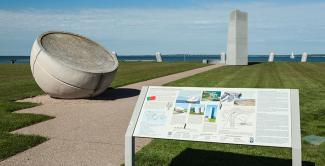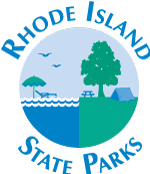Brenton Point State Park History (1976)

The story of Brenton Point begins with the earliest pages of Rhode Island history. The point of land was named for colonial Governor, William Brenton (1600-1674). As the tip of land furthest south on Aquidneck Island (also called the Island of Rhode Island), both its commanding view of the ocean and its rugged topography made it an ideal location for early settlement. For the same reason it is a striking location for a state park. The original 'plantation' or farm, encompassed not only the present park bounds, but also Castle Hill, Hammersmith Farm, and Fort Adams. The Hammersmith name was bestowed by Governor Brenton because it was the name of his original home in England.
As was the case with nearly all the original settlers of Newport, William Brenton was a religious refugee from the Massachusetts Bay Colony, centered in Boston. After living in Boston for four years, he was 'vigorously excused' in 1637, being one of the banned followers of religious enthusiast and out-spoken dissident, Anne Hutchinson. Along with the rest of the Hutchinson rebels, Brenton joined her little community in 1638 in Portsmouth, Rhode Island, before settling at the southern end of the island of Aquidneck in 1639. Unlike others who established the compact port area of the community which evolved into 'downtown' Newport, Brenton chose 2000 acres at the neck of land to the south of the town. He divided it into two farms. Eventually he had 11,000 sheep, plus horses and cows.
Brenton was one of those settlers who recognized that the relative isolation of the islands in Narragansett Bay with their already cleared land was very suitable for raising sheep. Curiously, the Puritans of nearby Massachusetts Bay who couldn't stomach the ideas of Roger Williams, and Anne Hutchinson, and their followers still had an appetite for the fat mutton raised on the Bay islands. Sheep raising on Aquidneck,. Conanicut (Jamestown), Prudence and other islands formed the basis of Rhode Island's earliest economy and earliest export cargoes. People like William Brenton became prosperous land owners as well as prominent political figures in the life of the colony.
Although the portion of Brenton's property which extended furthest into the ocean was always rough and windy, his over all estate, including its inner precincts, was very productive. Hector deCrevecoer, one of the later French travelers to Newport, once observed that it was a place where, "a man can farm with one hand and fish with the other."
William Brenton served as Governor of Rhode Island, 1666-1669; he had been Deputy Governor during the time when William Coddington was governor, 1640 to 1647. Coddington had been one of the wealthier settlers of Boston. His subsequent move to Rhode island helped to solidify the economy. He was also somewhat taken with himself and attempted to have the English King and Parliament award him with a life's appointment as the Governor of both island towns, Portsmouth and Newport, causing Roger Williams and others some alarm, and they took steps to get his appointment annulled. Brenton held office under the Charter of 1663, happily taking his chances in annual elections. He died in 1674.
Brenton's death occurred two years before Newport confronted its first real challenge. In 1675/1676, the Wampanoag Indian Chief, Metacomet, also known as King Philip, united a federation of Indian tribes to expel white settlers in the mainland Massachusetts and Rhode Island towns. Nearly all of Providence and Warwick, the outlying hamlet of Pawtuxet, were burned to the ground. Major battles took place in the Blackstone Valley; an Indian massacre occurred in South Kingstown's Great Swamp. Located more remotely on Aquidneck, Newport and Portsmouth were spared attacks but not the job of taking in refugees from the mainland.
In the chaotic quarter century that followed, Brenton Point and Castle Hill stood sentry to pirates who also sought refuge in Narragansett Bay. In the golden age of the merchant princes of Newport, who had emerged in the first half of the eighteenth century; Brenton Point became a portal to the successor of pirates, the Privateers -- commercial ships outfitted to wage war on England's enemies-- and to slave ships that were also part of the Newport harbor scene.
A century after Governor Brenton's death, the tables turned on Newport's fortunes. First it felt the brunt of England's own navy enforcing the rules of trade and the collection of shipping and taxes. Then, in 1776, Newport became a captured town, behind enemy lines, in the American Revolution. the American cannons at Brenton Point and Castle Hill, installed to keep the British out, defended against attempts by the Americans to free the inhabitants under British garrison control for three long years.
When the war was over, the town of Newport and its surrounding farms were devastated for decades to come, eventually rescued by a new form of 'invaders' in the guise of summer fun seekers. Many farm houses on the island before the American Civil War were converted to guest rooms. Victorian social life at first centered in great hotels, but then wealthy industrialists from New York, and as far away as Pittsburgh, began to build mansions along the Cliff Walk and out along the Ocean Drive that circled through Brenton Point.
Here, a fine house, known as 'The Reef' was built in 1885 for Theodore M. Davis by the Boston architectural firm of Sturgis and Brigham. An elegant shingle and stone-clad Queen Anne villa was erected to house Davis's collection of paintings and Egyptian artifacts, collected during his wanderings between 1903 and 1912. Under official license by the Egyptian government, Davis directed expeditions that uncovered nearly a half dozen major tombs, establishing important holdings for Egypt. The Reef was also famous for its walled gardens and green houses. The entire estate took up some eighteen acres.
After Mr. Davis' death in 1915 the estate went into the hands of Mr. and Mrs. Milton Budlong of Providence. The property suffered in the '38 Hurricane, but the members of the Budlong family used it until 1941. During World War II, the site's position as one of the gateways to Narragansett Bay made it an ideal location for a coastal artillery battery. Footings for these guns can be seen today. Returned to the Budlongs in 1946 the house and grounds remained unoccupied. The house continued deterioration in the 1950s, and a fire destroyed the villa in 1960. Two years later it was demolished. Surviving on the site are a bungalow and carriage house. In 1969 the site came under the control of the State of Rhode Island as an 'open space' property in the Green Acres Program. In 1976 it became a state park.
Today, the park boasts gardens, walking trails, and picnic tables. There are magnificent bay and ocean views. On foggy days the ghosts of merchant sailing ships, Navy Destroyers, and America's Cup challengers seem to play in the rolling waves just beyond the rocks. On most clear days it's a great place to fly kites. In 1988, carved stone monuments celebrating the role played by Portuguese explorers in southeastern New England waters were added to the park.
